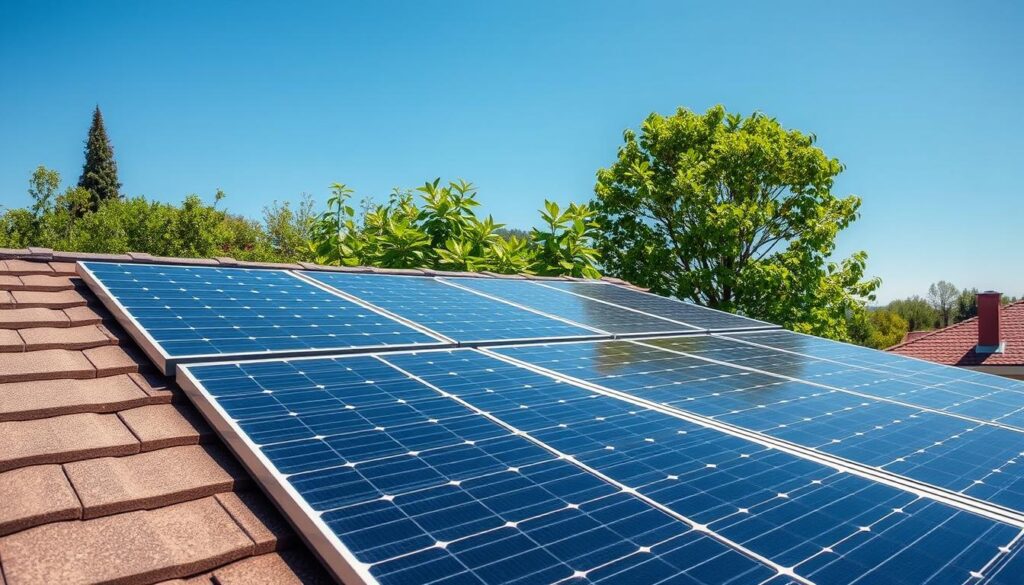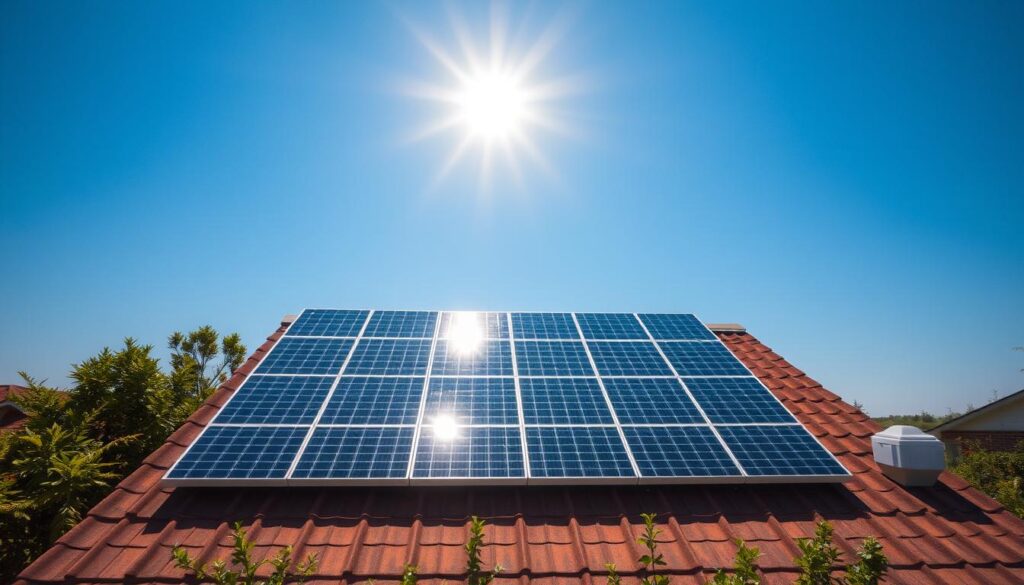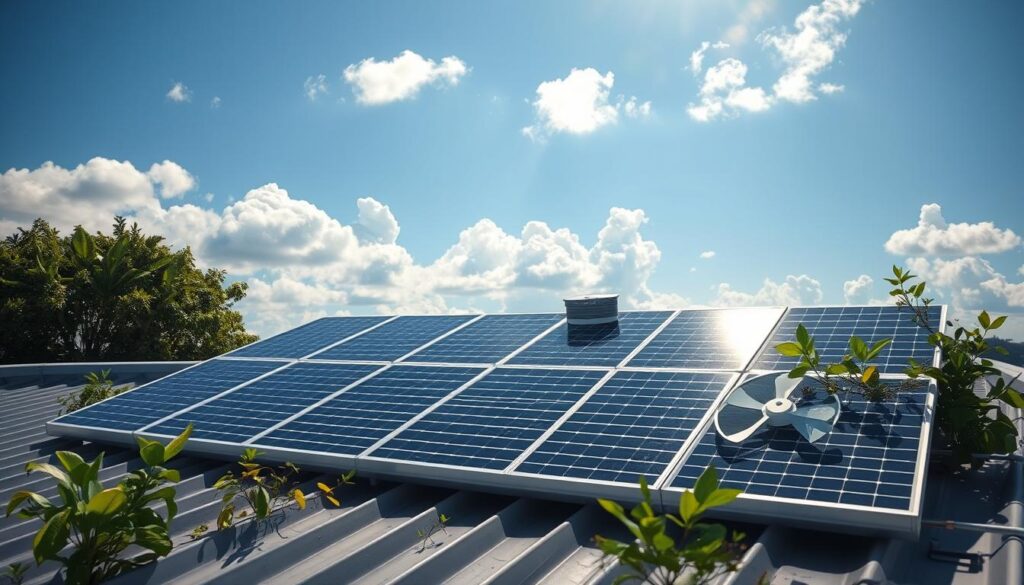The need for clean energy is rising fast. Making solar panel systems work better is key. This guide will show you how to get the most out of your solar energy. You’ll learn how to save money and help the planet at the same time.

Key Takeaways
- Understand the basics of solar panel systems and their efficiency ratings
- Learn how to place and orient your panels for the best sun exposure
- Discover ways to keep your panels cool for top performance
- Follow important maintenance and cleaning steps to keep your system running smoothly
- Use advanced monitoring to always improve your solar energy output
Understanding Solar Panel System Fundamentals
Starting your journey into solar power means learning about the different solar panels and their efficiency. You’ll find everything from sleek monocrystalline panels to more affordable polycrystalline ones. Each type has its own strengths in power output and performance.
We’ll also look at the key parts of a solar power system. This includes important items like inverters, batteries, and charge controllers.
Types of Solar Panels and Their Efficiency Ratings
There are mainly two types of solar panels: monocrystalline and polycrystalline. Monocrystalline panels are top-notch, with an efficiency of up to 22%. On the other hand, polycrystalline panels have an efficiency between 15% and 20%. Thin-film panels, though less efficient, are flexible and light, making them suitable for certain uses.
Key Components of a Solar Power System
A solar power system has several key parts that work together. They turn sunlight into electricity we can use. Keeping these parts in good shape is vital for the system’s performance. The main components are:
- Solar panels: These are where the magic happens, turning sunlight into electricity.
- Inverters: They change the direct current (DC) from the panels into alternating current (AC) for our homes.
- Batteries: They store extra energy for when the sun isn’t shining as brightly.
- Charge controllers: These keep the batteries from getting too full, which can damage them.
How Solar Energy Conversion Works
Solar power systems use the photovoltaic effect to turn sunlight into electricity. Sunlight hits the solar cells, causing electrons to flow and creating direct current (DC) electricity. This is how we tap into the sun’s energy to power our daily lives.
| Solar Panel Type | Efficiency Range |
|---|---|
| Monocrystalline | 18-22% |
| Polycrystalline | 15-20% |
| Thin-Film | 10-16% |
Optimal Solar Panel Placement and Orientation
To get the most out of solar panels, it’s key to place and orient them right. The best angle for catching sunlight changes with your location and latitude. Knowing the best angles helps ensure your panels work their best.
Best Angles for Maximum Sun Exposure
Solar panels should face the sun at an angle matching your location’s latitude. For instance, in New York City (latitude 40.7°N), tilt them about 40 degrees. This ensures they get the most sunlight all day.
But, you might need to tweak the angle a bit for seasonal changes. A few degrees more in winter and less in summer can boost energy production.
Geographic Considerations for Panel Installation
Where you live affects your solar panel’s efficiency. Places with lots of sun, like the southwest U.S., are great for solar power. But, areas with lots of clouds or trees might see less efficiency due to solar panel shading.
Dealing with Shade and Obstructions
Shade from buildings, trees, or other things can hurt your panels’ energy efficiency. It’s important to check the site for shade sources. Sometimes, trimming or removing trees is needed to get the most out of your solar panel orientation.
Using solar tracking systems can also help. They adjust the panels’ angle to follow the sun, ensuring they always face it for the best energy efficiency.

| Latitude | Optimal Tilt Angle | Seasonal Adjustment |
|---|---|---|
| 30°N | 30° | 25-35° |
| 40°N | 40° | 35-45° |
| 50°N | 50° | 45-55° |
Temperature Management and Performance Optimization
Keeping solar panels at the right temperature is key to their performance. When panels get too hot, they don’t work as well. This is because of something called the temperature coefficient.
To fight high temperatures, makers of solar panels have come up with smart fixes. Solar inverters are important because they turn the DC power from panels into AC power we can use. Microinverters and power optimizers help by making sure each panel works its best, even when it’s hot or shaded.
It’s important to keep an eye on solar panel temperature to get the most out of them. Things like placing panels right, using coolers, and picking efficient solar inverters help. These steps help keep panels cool and working well, making sure you get the most energy possible.
| Feature | Description | Impact on Efficiency |
|---|---|---|
| Microinverters | Inverters that are installed at the individual panel level, allowing for independent monitoring and optimization of each panel’s performance. | Helps mitigate the impact of temperature variations and shading on individual panels, leading to higher overall system efficiency. |
| Power Optimizers | Electronic devices that are installed between the solar panel and the central inverter, optimizing the power output of each panel independently. | Enhances the overall system efficiency by ensuring that each panel operates at its maximum power point, even under varying temperature and shading conditions. |

“Proper temperature management is essential for maximizing the efficiency and longevity of a solar power system.”
Essential Maintenance and Cleaning Protocols
Keeping your solar panel system in top shape is key. Regular cleaning and professional upkeep help your investment last longer and work better. This ensures it keeps giving you the best results for years.
Regular Cleaning Schedule and Techniques
Dust, debris, and bird droppings can block sunlight from reaching your panels. Set a cleaning schedule, usually every 6 to 12 months, based on your area’s weather. Use a soft-bristled brush or microfiber cloth to clean them. Avoid harsh chemicals or rough cleaners that could harm the panels.
Professional Maintenance Requirements
While you can clean your panels yourself, professional checks are vital. A pro can spot and fix problems like wiring issues or faulty inverters. They can also replace parts if needed, keeping your system running smoothly.
Monitoring System Performance
It’s important to watch how your solar panels perform. Check your energy output regularly. Look for any big changes or drops in energy. This helps you catch and fix problems fast, making your solar investment worthwhile.
FAQ
What are the key factors that affect solar panel efficiency?
Solar panel efficiency is influenced by several factors. These include the panel technology, how they are placed and angled, temperature, shading, and upkeep. Keeping them clean and well-maintained is also key.
How can I optimize the placement and orientation of my solar panels?
To get the most out of your solar panels, place them at the right angle for your area. Also, avoid shading from trees or buildings. Using a solar tracking system can help catch more sun throughout the day.
What are the best practices for maintaining and cleaning solar panels?
Clean your solar panels every 3-6 months to remove dirt. This boosts their efficiency. For complex issues, you might need a pro. Always check how well your system is working to catch problems early.
How can I regulate the temperature of my solar panels for optimal performance?
Keeping your solar panels cool is vital. High temperatures can lower their efficiency. Use techniques like proper orientation and ventilation to cool them down. New tech like microinverters can also help.
What is the role of solar inverters in maximizing system efficiency?
Solar inverters are crucial. They turn the DC power from panels into AC power for your home. Choosing efficient inverters, like string or microinverters, boosts your system’s performance.
How can I monitor the performance of my solar panel system?
It’s important to keep an eye on your solar system’s performance. Use tools like onsite displays, apps, or web portals. Your solar installer or equipment makers can help you with this.









